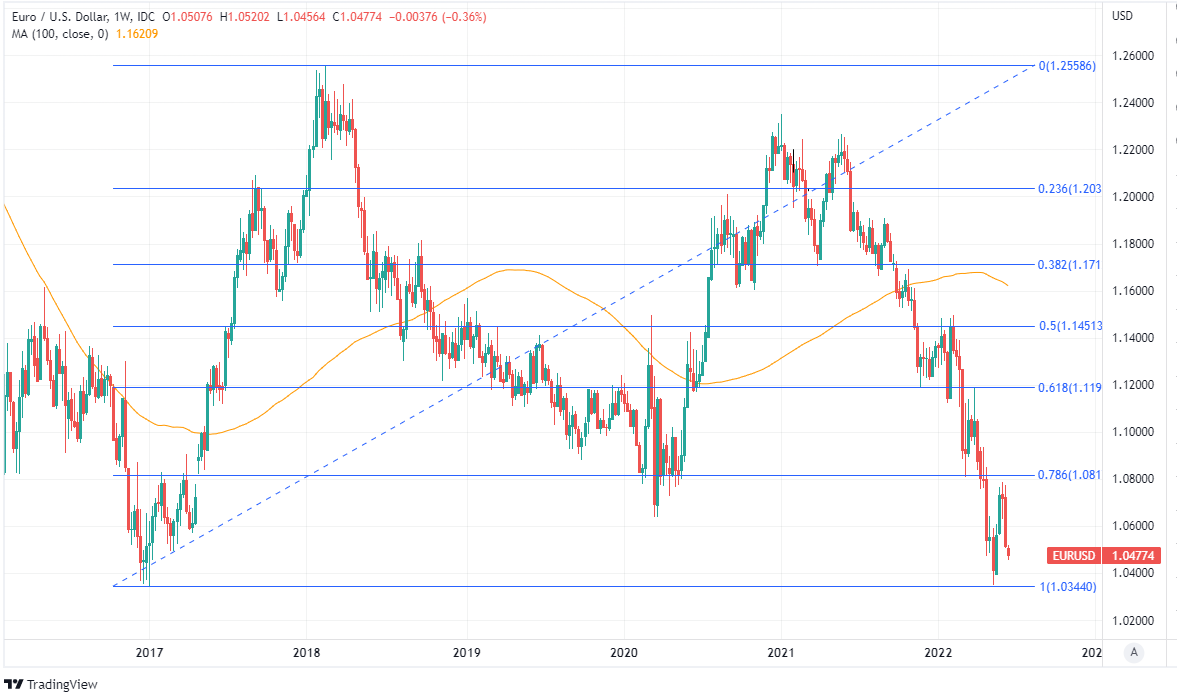EUR/USD Week Ahead Forecast: Vulnerable as Fed Risks Loom Large
- Written by: James Skinner
- EUR/USD struggling with dual central bank headwinds
- ECB stokes concerns about Southern European bonds
- As U.S. CPI acceleration incites faster Fed & lifts USD

Image © European Commission Audiovisual Services
The Euro to Dollar exchange rate fell heavily last week due to a toxic combination of domestic and international headwinds but could be likely to remain under pressure in the days ahead if U.S. bond yields and the Federal Reserve (Fed) policy outlook continue to sap risk appetite from global markets.
Europe’s single currency entered the new week trading back below 1.05 against the Dollar after U.S. inflation figures surprised on the upside of expectations for May on Friday and prompted the market to revise higher its expectation for Federal Reserve interest rates in the months ahead.
That data lifted U.S. bond yields and Dollar exchange rates while feeding an earlier sell-off in global stock markets that weighed heavily on many currencies, although the Euro was also left struggling in the wake of last week’s landmark European Central Bank (ECB) policy decision.
“Overall, the market is worried about energy prices (USD-supportive) worried that the Fed may have to tighten even faster (good for the dollar) and nervous of the way peripheral European bond spreads are blowing out (bad for the euro),” says Kit Juckes, chief FX strategist at Societe Generale.
The Euro was unable to capitalise when the ECB said last Thursday that it will begin raising Eurozone interest rates in July and that it expects to lift borrowing costs in a sustained way during the months ahead, and many analysts say this reflects market concerns about what higher rates will mean for Southern European bond markets.
 Above: Euro to Dollar rate shown at daily intervals with spread or gap between 02-year German and U.S. bond yields (orange) and S&P 500 (black). Click image for closer inspection.
Above: Euro to Dollar rate shown at daily intervals with spread or gap between 02-year German and U.S. bond yields (orange) and S&P 500 (black). Click image for closer inspection.
The ECB also announced a plan to use reinvestments of the €1.85 trillion bond portfolio acquired by its Pandemic Emergency Purchase Programme in order to prevent disproportionate and destabilising increases in financing costs for the more finanicially fragile Euro area members.
But this did little to prevent markets from expressing concerns about how Southern European economies and bond markets will fare as the bloc's interest rates rise and these kinds of concerns have a tendency to weigh on the Euro, which could now be even more vulnerable to the strengthening Dollar.
“The risk of a repeat of a summer like 2011 has increased as the market might want to discover more about the conditions (spread levels, speed of widening) that would be considered by the ECB to be an impairment of monetary policy transmission,” says Silvia Ardagna, chief European economist at Barclays.
There is little of significance in European calendar for the week ahead other than a Wednesday appearance by ECB President Christine Lagarde at the London School of Economics.
This potentially leaves the Euro at the beck and call of a Dollar that stands to benefit from Wednesday evening's Federal Reserve decision.
“We think the FOMC now has good reason to surprise markets by hiking more aggressively than expected in June. Accordingly, we change our forecast to call for a 75bp hike,” says Jonathan Millar, deputy chief U.S. economist at Barclays.
 Above: Euro to Dollar rate shown at weekly intervals with Fibonacci retracements 2017 uptrends indicating medium and long-term areas of technical support. Click image for closer inspection.
Above: Euro to Dollar rate shown at weekly intervals with Fibonacci retracements 2017 uptrends indicating medium and long-term areas of technical support. Click image for closer inspection.
The Fed is widely expected to lift U.S. interest rates by further large increment of 50 basis points, which would lift the Fed funds rate into a range of between 1.25% and 1.5%, although Friday’s inflation data has heightened the risk of the bank going further than that this week.
That data suggested that inflation could be set to remain elevated far above the Fed's 2% target for much longer than was previously expected by the bank and so could ultimately leave the Fed with little choice but to continue lifting rates in larger than usual increments through the remainder of the year.
This could potentially see the Fed lifting U.S. rates to 3% or more by year-end, which would be highly supportive of the Dollar and another burden for the Euro.
“Inflation is far too high in major developed markets, and central banks need to tighten financial conditions to slow the economy down and lower inflation,” says Zach Pandl, co-head of global foreign exchange strategy at Goldman Sachs.
“At some point financial conditions will tighten enough and/or growth will weaken enough such that the Fed can pause from hiking. But we still seem far from that point, which suggests upside risks to bond yields, ongoing pressure on risky assets, and likely broad US Dollar strength for now,” Pandl also said on Friday.




